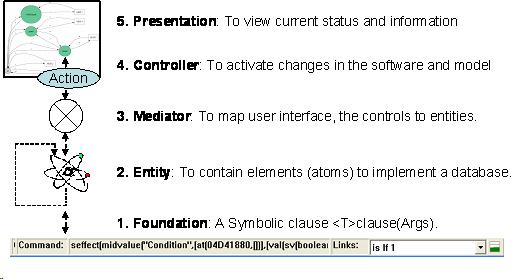Difference between revisions of "Symbolic analysis"
m |
(This page describes symbolic analysis for Visual Prolog rather shortly illustrating the philosophy, architecture and a sample of code.) |
||
| Line 15: | Line 15: | ||
<vip> | <vip> | ||
interface symbolicElement supports symbolic, drawableElement, etc. | interface symbolicElement supports symbolic, drawableElement, etc. | ||
| Line 43: | Line 43: | ||
<vip> | <vip> | ||
interface symbolic | interface symbolic | ||
open core | open core | ||
| Line 51: | Line 51: | ||
clause = | clause = | ||
def(defClause); %1 | def(defClause); %1 definitions for classes, methods, variables... | ||
creator(createClause); %2 | creator(createClause); %2 new class or new array | ||
ref(refClause); %3 | ref(refClause); %3 reference to variables | ||
get(getClause); %4 | get(getClause); %4 method invocations | ||
set(setClause); %5 assignmenets, incr/decr | |||
path(pathClause); %6 branches | |||
val(core::value); % constants | |||
etc. | etc. | ||
domains | domains | ||
symbolicType = ... | symbolicType = basicType(..) ; _class(..). | ||
domains | domains | ||
symbolicName = ... | symbolicName = className(string); methodName(string) ... | ||
end interface symbolic | end interface symbolic | ||
| Line 85: | Line 88: | ||
== Applications for the Framework == | == Applications for the Framework == | ||
The framework can be used for simulating source code, for implementing pie | The framework can be used for simulating source code, for implementing a pie, theorem provers, troubleshooting tools, simulators, as well as many other typical Prolog implementions, where there is one holistic domain to cover the whole semantics of the system. | ||
Revision as of 21:32, 14 December 2009
Symbolic analysis is a method for making interpretations based on symbols.  .
.
In figure there is an object to be monitored using a traffic light. That symbol is a signal to our eyes to activate an interpretation: to wait (red light), to be alert(yellow), or to go (green) ahead. In our brains there is a formal logic to handle interpretations from traffic lights. We suggest that our brains work like an automaton in traffic lights. Sometimes, when we are in a hurry, we ask questiong from ourselves: can we now go, can we now go... A detection from a traffic light causes a condition to be checked in the logic. It gives us the answer: You should wait, you should wait... Now you can go. That kind of symbol (traffic light) gives us pragmatic value, because it makes our travel safe, but still we can flexibly go further to home, work, trip etc - even when the traffic is very heavy.
That was the main principle of symbolic analysis in a nutshell.
Possible Uses for Symbolic Analysis
Symbolic Analysis written in Visual Prolog can be used in modeling typical formal systems, which meet requirements for atomisticity: formal languages, theorem provers, many mathematical packages, as well as simulation and optimization packages, where the type system has been written using Vip domains.
Obs. In PDC Prolog there are numerous examples of Prolog domains written for
Implementing a Symbol and Interpretation
Symbol is a reserved word in Visual Prolog, therefore we use the object SymbolicElement to model any Symbol.
interface symbolicElement supports symbolic, drawableElement, etc. predicates run: () -> clause* end interface symbolicElement class symbolicElement : symbolicElement constructors newModel: (string ModelName). new: (string ClassName). new: (string Name, symbolicElement ParentElement). end class symbolicElement implement symbolicElement supports symbolic inherits drawableElement, etc. end implement symbolicElement
The Symbolic Language
Clause is the base for the Symbolic Language.
interface symbolic open core domains program = clause*. clause = def(defClause); %1 definitions for classes, methods, variables... creator(createClause); %2 new class or new array ref(refClause); %3 reference to variables get(getClause); %4 method invocations set(setClause); %5 assignmenets, incr/decr path(pathClause); %6 branches val(core::value); % constants etc. domains symbolicType = basicType(..) ; _class(..). domains symbolicName = className(string); methodName(string) ... end interface symbolic
The architecture
There is a PCMEF-implementation for the symbolic analysis architecture:
- F means Foundation: The clause defintion is the carrier for all information in symbolic analysis.
- E means Entity: SymbolicElement is the base class for all specific entities in the model.
- M means Mediator: The static part of SymbolicElement contains the transformations and handles for Mediator.
- C means Controller: Controller is a set of utilities to change status of the elements.
- P means Presentation: Presentation is a graph created from model elements.
Summary for the Symbolic Analysis Framework for Visual Prolog
The SAM Framework creates a formal model for executing source code or any specific semantics expressed in Symbolic language as clauses. For each type of the element the domain symbolicType is defined. For each name type the domain is specified. These three definitions create a small mini computer to simulate any other computer as high abstraction.
The symbolic atomistic model is a conversion from a standard Prolog parse tree, where Prolog nodes in the tree have been replaced by links to the corresponding atoms, e.g. SymbolicElements.
Applications for the Framework
The framework can be used for simulating source code, for implementing a pie, theorem provers, troubleshooting tools, simulators, as well as many other typical Prolog implementions, where there is one holistic domain to cover the whole semantics of the system.

